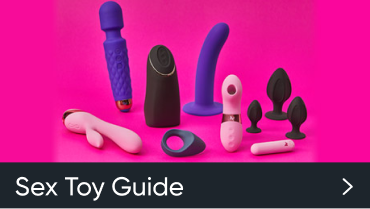Free Shipping over $59
Discreet and fast delivery
Free gift over $75+
Rewards program
Best price guarantee
Should I Tell My Partner I Use Toys?
When to share toy use and keep it secret
It’s the question so many of us have toyed with, pun intended!
Whether you have never used toys for sexual pleasure, fun or entertainment, ‘dabble’ with them as a casual user, or consider yourself to be a ‘frequent flyer’, having a conversation with your sexual partner about this is worth putting some thought into.
Before contemplating the pros and cons of telling your partner about your toy use, there are some basic questions to consider.
Toys and you!
- Are you comfortable yourself using toys?
- Are you comfortable talking about your toy use with a partner?
- If you use toys, do you prefer to do so alone or are you interested in sharing your toy experience with your partner (i.e. solo use or partnered play)?
These are the questions to think about to understand how comfortable you are with your own toy use and whether you are happy to include others. If you are comfortable with your toy use and talking about it with a partner, great! The key to remember is that sex toys can bring fun into your sex life and a light, romantic relationship is the best stimulant for good sex.

Toys and COVID-19
Yep, we had to mention that word. Although there are companies struggling globally with keeping their doors open, there are others like wildsecrets.com which are having a surge in the purchase on a variety of toys. (1)
What we know is that women are more likely to use toys then men. Men’s toys and women’s toys tend to focus on self-pleasure and enjoyment whereas couple’s toys tend to focus on mutual satisfaction and fun. Many couples, even those who have never used toys together before, are open to discussing toy use and even experimenting with toy kits.
However, the reality is that you are your safest sex partner, so if you are spending additional at home, what better to do than enjoy pleasuring yourself? Of course, you could introduce someone else to this experience if it’s safe to do so.
Just remember to take good care of your toys by using a compatible lubricant, quality toy cleaner and placing the toys in a clean and dry area away from the sun. The better care you take of your toys, the more use you will get out of them.
So, let’s take a moment to think through some questions to consider right before talking about toy use with a partner.
Before the talking
- Is this partner someone who you want to introduce to toys?
- Is this partner someone who you want to engage in toy use with?
- How much are you prepared to tell your partner about your toy use? and
- Are you wanting to slowly introduce toys to gauge the reaction of your partner before introducing even more?
Once you’ve managed to get through these questions and are convinced that yes, you absolutely want to start to have the toy conversation with your partner, then let’s consider a few more questions.

Talking about toys
- Do you want to tell your partner about all your toys or only a select few?
- When would be the best time to begin the toy conversation?
- How will you feel if your partner has a negative reaction to toy use?
- What will be the first toy that you believe you want to introduce?
It’s important to recognise that there is a range of toys available for his pleasure, her pleasure and couples alike. Some toys are more popular than others and some require actually reading through the instructions before using them.
There is a range of toys available for his pleasure, her pleasure and couples alike
Don’t worry if you feel a sense of reluctance, uneasiness or fear before taking the plunge to talk to your partner about toys. There are two main reasons that people contemplate not telling their partners about their use of toys. The first is the belief that “using a sex toy means your partner isn’t a good enough lover” – this is a common misconception that people have about sex toys.
The second reason is the assumption that one partner may also fear that another partner’s use of a sex toy will replace them, or that they’ll become overly reliant on the toy for arousal and/or orgasm – which will in turn devalue the relationship.
Be assured that both of these fears are unfounded and major assumptions rather than fact.
In the context of sex toys, positive communication ideally means that partners who feel unsure can open up about their concerns, feel heard and validated, and receive reassurance from their partners that a desire to use a toy is in no way an impingement on their virility, desirability, or sexual ability.
The alternative is also true – the partner who desires to use a sex toy should ideally, be able to communicate that desire without feeling or being judged, shamed, or otherwise pulled away from.

Have you ever had a conversation with one of your partners about their views on toys, toy use and sexual pleasure? If so, what was the outcome? Did you feel closer, heard and understood? Did you feel that you were better equipped to support your partner and share a mutually enjoyable relationship together?
If you haven’t previously had one of those conversations, ask yourself why not? What has been holding you back? What more do you need to know or do to feel comfortable and confident to talk about toys, toy use and sexual pleasure?
What more do you need to know or do to feel comfortable and confident to talk about toys, toy use and sexual pleasure?
In a 2016 study, researchers discovered that women and men who reported feeling satisfied by their relationship and the sex that they had with their partners were more likely to report having used sex toys together, in addition to other activities, such as taking a shower together, trying new positions in bed, and scheduling a date night to have sex. (2)
Generally speaking, couples who can explore novel ways of being intimate — including trying out one or more sex toys, fantasy role play, costume play, or even bedroom games — tend to fare better in terms of maintaining passion and desire, in addition to relationship satisfaction, over the long haul.
Remember that not everyone will have the same views or opinions on toy use as you will and that others are allowed their own opinions and you don’t need to let those opinions affect how you choose to engage in pleasuring yourself and/or others.
Sexual expression and sexual enjoyment with or without the use of toys is a normal and natural experience. Sexual satisfaction and maintenance of passion were rated as higher among people who had sex most frequently, received more oral sex, had more consistent orgasms, and incorporated more variety of sexual acts, mood setting, and sexual communication. (5) All of which you can find toys, lube and accessories to assist you to engage in.
Sexual expression and sexual enjoyment with or without the use of toys is a normal and natural experience
Therefore, should you tell your partner about your toy use? The answer to that question is one that only you are able to answer. I’ve simply been a guiding voice providing you with questions to ponder, statistics to inform you and information to guide you.
Remember that you, yes you – first and foremost – need to feel comfortable, safe and secure prior to even contemplating having the conversation about sex toys, solo play, partnered play and potentially mutual enjoyment. I wish you the most enjoyable and fulfilling sexual pleasure and life possible.
References
(1) Lee, B 2020, ‘Sex Toy Sales Are Buzzing With Social Distancing From COVID-19 Coronavirus’, Forbes, 26 April, viewed 3 September 2020
(2) Frederick, DA, Lever, J, Gillespie, BJ & Garcia, JR 2016, ‘What Keeps Passion Alive? Sexual Satisfaction Is Associated With Sexual Communication, Mood Setting, Sexual Variety, Oral Sex, Orgasm, and Sex Frequency in a National U.S. Study’, The Journal of Sex Research, vol. 54, no. 2, pp. 186-201, viewed 3 September 2020, DOI 10.1080/00224499.2015.1137854











